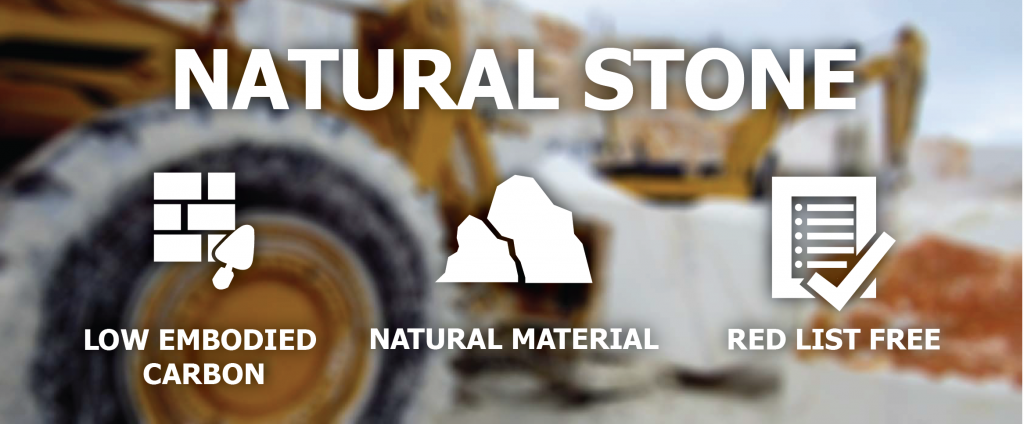
Words: Kathy Spanier, NSC 373 Joint Committee Chair
Photos: Natural Stone Council, TexaStone Quarry
More than ever before, sustainability is a high priority in the design and construction of today’s building projects. As environmentally responsible building products are becoming more in demand, material certification has become vital to verifying best practices that are being followed. The natural stone industry’s third-party-verified sustainability standard helps projects meet sustainability goals while providing an enduring product for the project’s entire life cycle.
With one of the lowest embodied carbon levels among building materials, natural stone has long been regarded for its inherently environmentally friendly properties. However, as the sustainable construction movement gained momentum, the building industry expressed the need for third-party-verified standards to ensure the validity of the manufacturer’s claims. In 2013, the natural stone industry responded by establishing a certification program to recognize its place as a leader in the sustainable products marketplace. The resulting standard, ANSI/NSC 373 for the Sustainable Production of Natural Dimension Stone, defines environmental, ecological, socially responsible, and human-health metrics for extracting and manufacturing natural dimension stone.
During the six years since the natural stone industry adopted the Natural Stone Sustainability Standard, companies across the country have certified their quarries and processing facilities by verifying their sustainable practices, and providing project teams with the information needed to make environmentally sustainable product choices. Quarries and fabricating facilities with the Certified Genuine Stone® label have achieved the voluntary ANSI/NSC 373 certification. In August of 2019, the standard was updated to make it even easier for project teams to recognize sustainably produced natural stone and meet requirements for projects with green building goals.
Verified with Certainty
The natural stone industry knew third-party verification would be essential to developing the standard as well as to the process of certifying to the standard. No longer could natural stone quarriers and fabricators rely on self-reporting their metrics in today’s eco-conscious marketplace.

During the initial development of the standard, the Natural Stone Council (NSC) — a collaboration of trade associations to promote the use of natural stone – obtained perspective from both inside and outside the industry. To help guide the process, they turned to assistance from Ecoform of Knoxville, Tennessee, and NSF International of Ann Arbor, Michigan, to determine the environmental effects of how stone is quarried, transported, and processed. They also established the ANSI/NSC 373 joint committee, comprised of members from a cross-section of stakeholders who remain committed to ensuring the standard is relevant within the green building industry.
But sustainability is not a new concept in the stone industry.
Industry-leading quarriers and fabricators have had environmentally responsible practices in place for years. Many companies in the stone industry have a long history of good stewardship of the land and the material production process. It is also important to understand the difference between mining and quarrying. Modern quarry operations have a small footprint when compared to the mineral extraction process. In most cases, quarries have operated in one location for many decades, creating material for thousands of residential and non-residential construction projects from within that small footprint. Now, when quarriers and fabricators of natural dimension stone certify to the standard, they definitively verify the credibility of their practices.
Further validating the standard, accreditation was given by the American National Standards Institute (ANSI). Many in the building industry are familiar with ANSI, an organization that oversees the creation and use of thousands of tests, standards, and guidelines in the United States.
The Natural Stone Sustainability Standard third-party-verifies a set of well-defined metrics for extracting and manufacturing natural dimension stone. For the industry as a whole, including non-certified companies, it provides a method for improving baseline environmental performance for stone. Ultimately, NSC has a goal of educating key members of the design and building professions as to the value and benefit of using natural stone and how to incorporate certified stone into different projects.

Rigorous Process
When stone companies seek ANSI/NSC 373 certification, a third-party such as NSF International supervises the rigorous certification process. The first step is a document review, followed by an onsite audit. A desk audit is verified by the site audit prior to the administration of certification.
To achieve certification, companies must achieve points in numerous areas of stone production, including:
- water usage and recycling
- custody and transportation of the stone
- site management
- land reclamation and adaptive reuse
- corporate governance
- energy inventory & carbon management
- management of excess process materials and waste
- safer chemical and materials management
- human health and safety
- innovation
In each of the above categories, companies earn points toward achieving a Bronze, Silver, Gold or Platinum level certification. Certification is also site-specific. Companies with multiple quarries must have each location evaluated separately.
As a continuous-improvement certification program, re-certification takes place every three years. Years two and three of certification include a desk audit only. Year four involves an on-site audit in addition to the desk audit review for recertification. Companies can upgrade to a higher level of certification at any time.
The standard also includes a companion Chain of Custody (NSC COC) program to further elevate the process. NSC COC traces the stones as they travel from the quarry to processing and through the supply chain, ultimately to their journey’s end.
Each organization handling the stones at each step along the way must be COC certified, conforming to the COC standard, for the stone to retain certification. Products achieving COC certification will have the “Certified Genuine Stone®” logo, making these products a preferred choice for responsible consumers.
As project teams consider the benefits of certified stone, they should realize the Natural Stone Sustainability Standard is cradle-to-gate. It applies to quarry operations through final fabrication. while the standard doesn’t measure life-cycle impacts when stone leaves the fabrication facility, it does allow decision-makers to look more closely into the manufacturing process in their examination of a product’s life-cycle assessment. What’s more, natural dimension stone producers in both domestic and international markets can participate in the Natural Stone Sustainability Standard – an important criterion in today’s global marketplace.
The credible process of natural stone certification helps projects achieve specific green building requirements. Projects seeking green building certification can choose certified natural stone to achieve their design goals: the standard aligns with materials and resource credits for U.S. Green Building’s Leadership in Energy and Environmental Design (LEED) v.4 / v.4.1 and the materials petal of International Living Future Institute’s Living Building Challenge (LBC) projects.

2019 Updates
In August 2019, NSC in conjunction with NSF published an updated version of ANSI/NSC 373. Six years after the standard was adopted, the building and design market continues to demand greener and more sustainably produced materials, and green building programs must evolve to meet the rising needs. Updates to the natural stone certification reflect the stone industry’s commitment to aligning with green building programs.
The 2019 updates address slight adjustments to a broad scope of criteria including water, site management, land reclamation and adaptive use, corporate governance, management of excess process materials, and innovation. They also address a wider range in the variability of operations, natural stone dimensional deposits and regulatory requirements across the country.
The heart of the Natural Stone Sustainability Standard is continuous improvement. The recent updates to the standard demonstrate the industry’s desire to continually improve based on feedback from certified companies and key green building programs to ensure it remains relevant in the ever-changing marketplace.
Merits of Choosing Certified Stone
Now that natural stone has a sustainability standard, design teams, contractors and consumers can know with certainty that the stone for their project – whether imported from another country or the project’s backyard – is produced in a sustainable manner.
The standard confirms natural stone as a leading material among building product choices. Beyond its ability to bring clarity to some misconceptions, perhaps the standard’s biggest benefit is third-party verification. For years, the stone industry has either not reported or self-reported its practices related to sustainability, but the new standard requires an outside party to be involved in the certification process. For all members of the project team, third-party verification is key to the process because it confirms authenticity.

When it comes to sustainable, durable, natural products, ANSI/NSC 373 certification has made natural stone a clear choice. The natural stone sustainability standard is a great achievement for the stone industry, which is dedicated to aligning with the continually evolving marketplace. The industry will continue its efforts to respond and ensure everyone on the project team understands the benefits of choosing natural stone.
About the Natural Stone Council
In 2003, the Natural Stone Council (NSC), a not-for-profit organization, was formed to unite a diverse industry of natural stone producers to actively promote the attributes of natural stone in commercial, residential, government, institutional, educational and all types of applications interior and exterior, and to proactively position natural stone as the premier construction material. The NSC is comprised of organizations representing every type of dimensional stone quarried and fabricated in the United States. For more information, visit www.naturalstonecouncil.org. To access the ANSI/NSI 373 standard and find a full list of certified stones and how to source them, visit www.naturalstonecouncil.org/sustainability.













